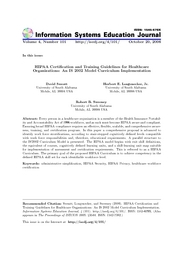Volume 4
Volume 4, Number 101 |
October 20, 2006 |
Abstract: Every person in a healthcare organization is a member of the Health Insurance Portability and Accountability Act of 1996 workforce, and as such must become HIPAA aware and compliant. Ensuring broad HIPAA compliance requires an effective, flexible, scalable, and comprehensive awareness, training, and certification program. In this paper a comprehensive proposal is advanced to identify work force stratifications, according to stair-stepped cognitively defined levels compatible with work force responsibilities and, therefore, educational requirements. A parallel structure to the IS’2002 Curriculum Model is presented. The HIPAA model begins with exit skill definitions, the equivalent of courses, cognitively defined learning units, and a skill-learning unit map suitable for implementation of assessment and certification requirements. This is referred to as a HIPAA Curriculum. The primary goal of the proposed HIPAA Curriculum is to achieve competency in the defined HIPAA skill set for each identifiable workforce level.
Keywords: administrative simplification, HIPAA Security, HIPAA Privacy, healthcare workforce certification
Download this issue: ISEDJ.4(101).Sweatt.pdf (Adobe PDF, 13 pages, 608 K bytes)
Preview the contents: Sweatt.j.txt (ASCII txt, 32 K bytes)
Recommended Citation: Sweatt, Longenecker, and Sweeney (2006). HIPAA Certification and Training Guidelines for Healthcare Organizations: An IS 2002 Model Curriculum Implementation. Information Systems Education Journal, 4 (101). http://isedj.org/4/101/. ISSN: 1545-679X. (A preliminary version appears in The Proceedings of ISECON 2005: §3544. ISSN: 1542-7382.)
